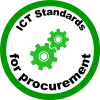The contents included in this section are DRAFTS and are under review.
Maximising the potential growth of the European Digital Economy requires investment in ICT infrastructures and technologies, such as Cloud Computing, to boost industrial competiveness and provide better public services. In simple terms, Cloud computing is the storing, processing and use of data stored on remotely located computers accessed over the internet. Users can draw upon almost unlimited computing power and access their data from any internet connection, while reducing capital investment needs.
Cloud Computing is increasingly the chosen platform for the provision of new ICT infrastructure, services, software and applications. By using the cloud, small firms can reach out to large markets, while governments can make their services more attractive and efficient while reining in spending.
However, the drastic changes in the delivery and use of information technology represented by Cloud Computing creates new challenges which must be addressed, including the interoperability of different clouds and cloud services, and the portability of data stored on a cloud.
These communications of the EC explain the policy framework:
• COM(2012)529 Unleashing the Potential of Cloud Computing in Europe
• COM(2015)192 A Digital Single Market Strategy for Europe
Subdomains
Subdomains describe specific cases of application of ICT solutions in the domain. Selected cases for cloud computing are:
List of Standards
For the purposes of the public consultation, a DRAFT list of standards (version 2, update 31/03/2017) applicable to the topics treated in this domain has been created and can be dowloaded for perusal and comments.
The review and consultation stage aims at: adding/removing items; and classifying items as standards/technical specifications/others following appropriate regulations.

You contribution will be much appreaciated. Please leave feedback in the forum.

Resource Description Framework

ETSI TCR-TR 029:1995 - Security Techniques Advisory Group (STAG) - A directory of security features in ETSI standards

ETSI ETR 332:1996 - Security Techniques Advisory Group (STAG) - Security requirements capture

ETSI ETR 237:1996 - Security Techniques Advisory Group (STAG) - Baseline security standards - Features and mechanisms

ETSI ES 202 383 V1.1.1 (2005-04) - Telecommunications and Internet converged Services and Protocols for Advanced Networking (TISPAN) - Security Design Guide - Method and proforma for defining Security Targets

ETSI ES 202 382 V1.1.1 (2005-04) - Telecommunications and Internet converged Services and Protocols for Advanced Networking (TISPAN) - Security Design Guide - Method and proforma for defining Protection Profiles

DRAFT ETSI EN 303 204-2 V1.1.0 (2014-06) - Electromagnetic compatibility and Radio spectrum Matters (ERM); Network Based Short Range Devices (SRD); Radio equipment to be used in the 870 MHz to 876 MHz frequency range with power levels ranging up to 500 mW

DRAFT ETSI EN 303 204-1 V1.1.0 (2014-06) - Electromagnetic compatibility and Radio spectrum Matters (ERM); Network Based Short Range Devices (SRD); Radio equipment to be used in the 870 MHz to 876 MHz frequency range with power levels ranging up to 500 m

ETSI EN 303 204 V2.1.0 (2015-07) - Network Based Short Range Devices (SRD); Radio equipment to be used in the 870 MHz to 876 MHz frequency range with power levels ranging up to 500 mW; Harmonised Standard covering the essential requirements of article 3.2




